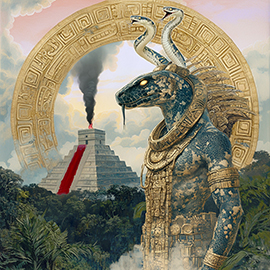
Yig
 The half-human father of serpents, shunned and feared in central Oklahoma. Yig was the snake-god of the central plains tribes, presumably the primal source of the more southerly Quetzalcoatl and Kukulcan. Yig is said to be half-anthropormorphic, appearing like a man unless viewed closely. His character is arbitrary and capricious. Though typically well-disposed to those who honor him and all serpents, he punishes those who harm snakes. After suitable tortures, Yig's victims are transformed into spotted snakes. [HPL Yig (online text); Mound (online text)]
The half-human father of serpents, shunned and feared in central Oklahoma. Yig was the snake-god of the central plains tribes, presumably the primal source of the more southerly Quetzalcoatl and Kukulcan. Yig is said to be half-anthropormorphic, appearing like a man unless viewed closely. His character is arbitrary and capricious. Though typically well-disposed to those who honor him and all serpents, he punishes those who harm snakes. After suitable tortures, Yig's victims are transformed into spotted snakes. [HPL Yig (online text); Mound (online text)]
In the autumn, Yig becomes unusually ravenous, and has to be driven away by means of suitable rites. Then the Indians conduct orgies in lonely places, with the ceaseless beating of tom-toms. When the corn harvest comes, the Indians give Yig some corn, and dance in proper regalia to the sound of whistle, rattle, and drum. They keep the drums beating to drive Yig away, and call down the aid of Tirawa, the father of humanity. [Yig (online text)]
Walker Davis first leaned of Yig beliefs at Okmulgee in Creek country. The Wichita have protective charms against Yig, which they taught to Davis. Audrey Davis dreamed of Yig appearing in the guise of Satan. When their house was infested with snakes, she took it as a sign that the curse of Yig was at work, and found it significant that their house was invaded by snakes on Halloween. Following her traumatic encounter with the snakes, Audrey went insane. After nine months, she gave birth to three children with snake-like deformities. [Yig (online text)]
In K'n-Yan
Yig was one of the principal deities worshipped among the Old Ones (3) of K'n-yan, beneath the mound outside Binger, Oklahoma. Grey Eagle said that Yig, big father of snakes, is there at the mound outside Binger. Grey Eagle loaned the Mound narrator a talisman with a serpent design, perhaps related to Yig. The cylinder containing Zamacona's memoir had a carving of a semi-anthropormorphic serpent, which the Mound narrator identified as a prototype of the Yig, Quetzalcoatl, and Kukulcan conceptions. Charging Buffalo said that the Old Ones of K'n-yan worshipped Yig. Inside the passageway leading to K'n-yan, Zamacona observed carvings of Yig. The Old Ones regarded Yig as the principle of life symbolized as the Father of all Serpents; their cryptic shrines to Yig were lavish and remarkable, surrounded by embowering groves. Among the Old Ones, days were of variable length, and said to be timed by the tail-beats of Yig. In their calendar, the year was measured by Yig's annual shedding of his skin. The cult of Yig was still active when Zamacona was in K'n-yan. The leaders of Yig worship were shocked by Zamacona's dreams of the abyss of N'kai. In a passage leading up to the surface, Zamacona saw nitre-encrusted images of Yig ; the Mound narrator later also viewed them. [Mound (online text)]
In Ancient Mu
Yig was one of the gods worshipped by the first human race in primal Mu [HK Invaders (online text)]. In ancient Mu, T'yog believed that Yig was among the gods friendly to man, who might take sides with us against Ghatanothoa [HPL Aeons (online text)].
Elsewhere
Georg Reuter Fischer heard voices droning "The legend of Yig" [FL Terror2]. The being impersonating Henry Akeley told Albert Wilmarth the truth behind the legend of Yig [Whisperer (online text)].
De Vermis Mysteriis refers to Father Yig as a god of divination [RB Shambler (online text)].
Our own American Indians believed in Yig [RB Serpents].
Simon Maglore asked a farmer near Bridgetown about "the ritual of Father Yig" [RB Mannikin].
A secret cult in Haiti worships deities called the Old Ones (misc), including Yig [HC Pits].
Boys in the late Elmer Harrod's house heard the name Yig chanted from underground [JVS Dead].
Winfield Phillips read of Yig, the terrible snake-god [AWD Lurker 134].
Aka: Father of Serpents.
Compare with: Niguratl-Yig; serpent god; Snake-God.
Return to Cthulhu Universalis Contents Page
Return to CthulhuFiles.com Home Page
Send comments to jfm.baharna@gmail.com.
© Copyright 1996-2025 by Joseph Morales
